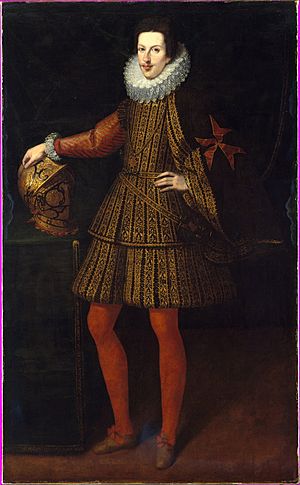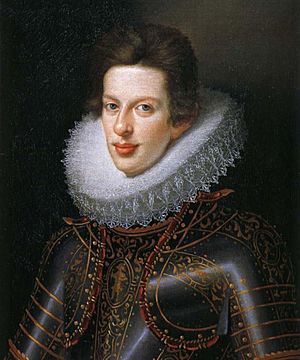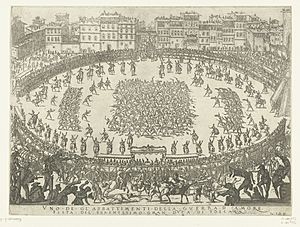Cosimo II de' Medici, Grand Duke of Tuscany facts for kids
Quick facts for kids Cosimo II |
|||||
|---|---|---|---|---|---|

Cosimo II after Justus Sustermans
|
|||||
| Grand Duke of Tuscany | |||||
| Reign | 17 February 1609 – 28 February 1621 | ||||
| Predecessor | Ferdinando I | ||||
| Successor | Ferdinando II | ||||
| Born | 12 May 1590 Palazzo Pitti, Florence, Tuscany |
||||
| Died | 28 February 1621 (aged 30) Palazzo Pitti, Florence, Tuscany |
||||
| Spouse | Maria Maddalena of Austria | ||||
| Issue Detail |
Maria Cristina Ferdinando II, Grand Duke of Tuscany Cardinal Gian Carlo Margherita, Duchess of Parma Mattias, Governor of Siena Francesco Anna, Archduchess of Austria Cardinal Leopoldo |
||||
|
|||||
| House | House of Medici | ||||
| Father | Ferdinando I | ||||
| Mother | Christina of Lorraine | ||||
| Religion | Roman Catholicism | ||||
Cosimo II de' Medici (born May 12, 1590 – died February 28, 1621) was the Grand Duke of Tuscany. He ruled from 1609 until his death. Cosimo was the oldest son of Ferdinando I de' Medici, Grand Duke of Tuscany, and Christina of Lorraine.
For most of his twelve years as Grand Duke, he let his trusted ministers manage the government. Cosimo is best known for being a strong supporter of Galileo Galilei. Galileo was a famous scientist and had been Cosimo's childhood teacher.
Contents
Life of Cosimo II de' Medici


Cosimo's father, Ferdinando I, made sure he received a modern education. From 1605 to 1608, the famous scientist Galileo Galilei was Cosimo's tutor. In 1608, Ferdinando arranged for Cosimo to marry Archduchess Maria Maddalena of Austria. She was the daughter of Archduke Charles II.
Their wedding was a huge celebration on the Arno River. It included a play called Argonautica. In this play, Jason sailed around a fake island. He then gave Maria Maddalena six red apples. These apples were a symbol of the Medici family's crest. Cosimo and Maria Maddalena had eight children in just eight years. Their children included Cosimo's future successor, Ferdinando II. They also had an Archduchess, a Duchess, and two cardinals.
Becoming Grand Duke and His Rule
Ferdinando I passed away in 1609, and Cosimo became the Grand Duke. Cosimo was not very healthy, so he did not take a very active role in running his country. However, he was a great supporter of science and learning. Just over a year after Cosimo became Grand Duke, Galileo dedicated his book, Sidereus Nuncius, to him. This book described Galileo's amazing discoveries using a telescope.
Cosimo also expanded the Palazzo Pitti in Florence. He also rebuilt the villa of Poggio Imperiale. Even though he wasn't deeply involved in daily government, the Grand Duke worked hard to make the navy bigger and stronger.
Cosimo II died on February 28, 1621, from tuberculosis. He was only 30 years old. His oldest son, Ferdinando II, became the new Grand Duke. Ferdinando II was still a child when his father died. Cosimo II had wished for his wife and mother to rule until his son was old enough.
Supporting Arts and Science
Cosimo II was a big supporter of smart and creative people. He helped scientists and artists.
Science and Galileo Galilei
In 1610, Galileo Galilei was named the court mathematician to Cosimo. This job meant Galileo did not have to teach at universities anymore. As court mathematician, Galileo could focus on his own research. He was free to explore new ideas and support the theories of Nicolaus Copernicus. Copernicus believed the Earth orbited the Sun, not the other way around. Galileo used math to explain his ideas about physics.
Galileo was already famous for his telescope discoveries. He used these to get Cosimo's support. Once he had the job, Galileo moved to Florence. He found a place with many resources. There, he worked as a philosopher, mathematician, and astronomer. Galileo was an active part of court life. He used his work to support the Medici family's importance.
Besides creating amazing scientific shows, Galileo used the Medici court to share his discoveries. He had found four moons orbiting Jupiter. He named them Medicean Stars to honor Cosimo and his three brothers. Tuscan ambassadors helped spread scientific ideas across Europe. Ambassadors in cities like Prague, Paris, London, and Madrid received copies of Galileo's Sidereus Nuncius. They also got telescopes built by Galileo, paid for by the court.
Art and Jacques Callot
A well-known artist named Jacques Callot worked for Grand Duke Cosimo II. He stayed at the court until Cosimo died in 1621. Callot drew pictures of the big parties and carnivals in Florence. His drawings show us what these events looked like.
Cosimo II's Children
Cosimo II and Maria Maddalena had eight children:
- Maria Cristina de' Medici (August 24, 1609 – August 9, 1632), she never married.
- Ferdinando II de' Medici, Grand Duke of Tuscany (July 14, 1610 – May 23, 1670), who married Vittoria della Rovere and had children.
- Gian Carlo de' Medici (July 24, 1611 – January 23, 1663), he never married.
- Margherita de' Medici (May 31, 1612 – February 6, 1679) married Odoardo Farnese, Duke of Parma, and had children.
- Mattias de' Medici (May 9, 1613 – October 14, 1667), he never married.
- Francesco de' Medici (October 16, 1614 – July 25, 1634), he never married.
- Anna de' Medici (July 21, 1616 – September 11, 1676), married Ferdinand Charles, Archduke of Austria (1628–1662) and had children.
- Leopoldo de' Medici (November 6, 1617 – November 10, 1675), he never married.
See also
 In Spanish: Cosme II de Médici para niños
In Spanish: Cosme II de Médici para niños




